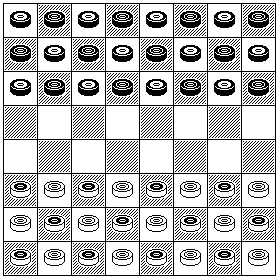
The fact that the English and American game of Checkers requires such measures to be taken as the two-move and three-move restrictions, or the eleven-man ballot, is irksome to some, but it has not prompted people in the English-speaking world to switch en masse to the internationally-recognized form of Checkers which is played on a 10 by 10 board. One reason that has been cited for this is that absent existing demand for 10 by 10 boards, they are not easily available locally in much of the English-speaking world. As well, in my opinion just as important a factor is that the considerably different rule for captures in that form of the game may make it less appealing to those who enjoy the English form of Checkers.
Modifying Checkers so that it is very nearly the same game as before, and yet is also still played on the same 8 by 8 board, and yet is a considerably more profound and complex game, so that measures like the three-move restriction would not be required, seems like a rather tall order.
Only after hearing of the game of Gothic Checkers did I have the inspiration I needed to make the attempt:
This, in itself, would seem likely to produce a very interesting game. As in Gothic Checkers, each piece will always remain on the color of squares it started from. Thus, in the diagram above, it is shown that if special equipment particularly for this game is made, pieces could be crafted so that the center of the piece would indicate the color of squares on which it is played, and the perimeter of the piece would indicate the side to which it belongs.
I wish, however, to propose some additional rules.
The first is to give the kings the additional power of jumping over men of their own color without capturing them. Such jumps are purely optional, but if they leave the king making them in a position to make a capturing jump, then it is compulsory to continue with that capturing jump, and any further capturing jumps that it leads to.
This move is, of course, inspired by the old Parker Brothers game Chivalry and its successor Camelot, which are discussed on another page. Here, however, after a series of capturing jumps is completed, jumping may optionally continue with another non-capturing jump over a man of one's own color during the same move.
One major aspect of the significance of a move of this type is that it provides a discretionary capturing move.
The second variant rule, predicated on also including the first one, is based on the assumption that the game has now been made so much more challenging that it will remain sufficiently challenging even in the Jeu Plaisant form, where capturing is optional, rather than compulsory, when the opportunity presents itself. A series of capturing jumps, however, once begun must be completed, but it is not obligatory for a king to begin a series of capturing jumps after a series of non-capturing jumps in this variant.
It is thought that this second variant rule, if it is practical to adopt it, will have two advantages; it will make the game more appealing to new players, and by removing an element of mechanical calculation from the planning of moves, it will alter the disparity between human and computer skill at the game to the advantage of humans.
A third variant rule, independent of the second, but requiring the first, would be to allow men as well as kings to make non-capturing jumps, but with the limitation, in the case of men, that these jumps could only be made orthogonally, and not diagonally. This might further enrich the game by further ramifying the interaction between the two colors of square on the board.
It is the first variant that I would like to present as the first candidate for consideration as a game which resembles the English form of Checkers, yet which has the depth needed to remain competitive at the highest levels without adding a restriction.
A fourth possible modification to the rules would be to even more closely follow the lead of Chivalry, and allow men to also make non-capturing jumps in the forwards diagonal directions as well as forwards and sideways, but not to allow them to combine capturing and non-capturing jumps in the same move. I avoided that possibility, as my goal was to have a game that strongly resembles Checkers, and making elements from Halma or Chinese Checkers a significant part of the game would detract from that goal; also, something that would speed up the game significantly (by allowing men to promote to kings more quickly) might also have a tendency to simplify it.